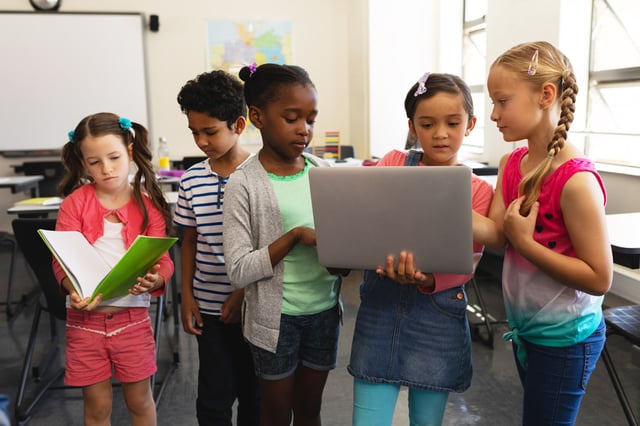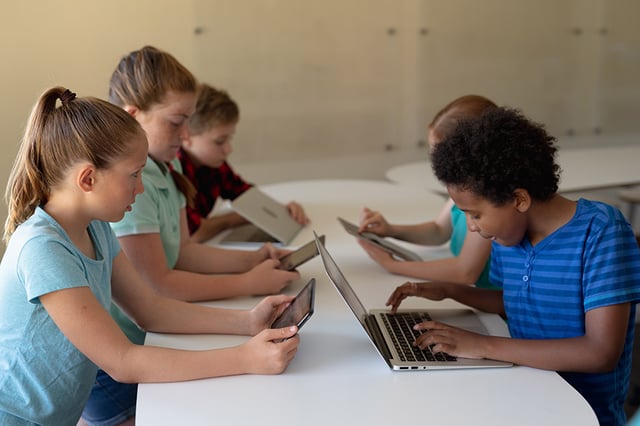Pursue Digital Equity Through Access and Opportunity – All Means All
 Written By Matthew Hiefield
Written By Matthew Hiefield
For the past several years, a lot of focus has been placed on putting technology in our schools. Most schools today have some technology available for classroom use, although the amount of technology varies greatly across the US. The recent documentary Without A Net does a great job of illustrating the challenges facing many of our schools and the great variance in technology availability.
In addition, the strength of school networks also plays a role. When there is not enough bandwidth to accommodate access and applications don't load or crash, the frustration and waste of instructional opportunities mount.
When new devices arrive and cannot connect, they often end up gathering dust in the back of a classroom or in a storage closet. Despite these challenges, improvements are being made and students are gaining more access to technology in schools while connectivity challenges outside of schools are evolving and becoming more nuanced.
The First Digital Divide: Access
Connectivity for students is an ongoing challenge, even in our wealthiest of districts. There is no one solution, but reaching out and looking at challenges facing students and families is essential. A recent study by the ACT Center for Equity in Learning shows that the definition of what it means to be connected is evolving. It used to be a yes or no question of home connectivity. Increasingly, though, it is a matter of how many devices a student has access to in his or her family. For example:
“Students with access to only one device may need to share that device with other family members in their household. These family members might include siblings who also need the device for homework and other school-related activities. This limits the availability of the device for homework, college applications, and the like. In addition, if the device breaks, students will not have an additional device with which to complete school-related activities. Students with access to more than one device are less likely to face these challenges.”
When several family members are competing for connectivity time that perhaps includes limited data, a student’s ability to fulfill school assignments can be challenging at best. Finding out the extent of the digital divide in an individual school district is a starting point, and it means being intentional and transparent in asking questions to students and families.
Once a district gets a general idea of the extent of the challenge, there are several avenues to explore to help students. Here are a few that we have tried in the Beaverton School District in Beaverton, Oregon.
Hotspot Pilot Project: We piloted a small hotspot project in one of our high schools – giving students access to WiFi hotspot devices they could take home – and quickly learned that demand far exceeded the supply. The project included help and guidance from the school’s student leadership, administration, and library and tech teachers, as well as district librarians.
WiFi Access Maps: Some of our schools in highly impacted areas contacted local businesses to see if they would be willing to allow students to use their WiFi after school hours. This proactive approach helped to build community support and engage others with our access challenges. (Check out one of our sample WiFi maps, in English and Spanish, here.)
Sprint 1 Million Hotspot Grant: In the Spring of 2017, our Digital Equity Team applied for a Sprint 1 Million hotspot grant. This is a five-year grant that provides 400 hotspots a year for distribution to our neediest students and will run through 2022.
Latino Tech Parent Nights: We host Latino family technology nights to educate parents on how to support their students with technology. Many of these parents have not used a computer before, so educating them about digital citizenship, expectations, and parenting helps show them the value of being connected and being ready for the future.
Focus on High-Needs Schools: To meet the needs of middle and elementary schools, we are piloting a Kajeet hotspot project at three of our highest-needs schools. We are working closely to gather data on teaching and learning at these schools in order to inform future adoptions.
School and District Surveys: We added questions about home internet connectivity in our district-wide student survey to help us make informed decisions about future steps.
Extended Library Hours: To support students, we extended library hours. In addition, the district provided transportation for students who depend on bussing.
The Second Digital Divide: Instruction
More devices and improving networks, though, do not guarantee meaningful interactions with technology. Sociologist Paul Atwell observed that even as technology gaps close, a second divide often becomes increasingly apparent:
"Affluent students use the same technologies to support richer forms of learning with greater adult mentorship. This first section of the report offers evidence of how inequity persists despite removing technical and economic barriers, and what we know about the social and cultural forces that determine these inequitable outcomes." (Connected Learning Alliance Report)
In the late 1990's and again in 2010, studies showed that "low-income, nonwhite children more often used technology in math class for drill and practice, while affluent, white children were more likely to use technology for graphing, problem-solving, and other higher-order exercises" (Boser, Ulrich. 2013).
The second digital divide becomes more apparent when looking beyond the "number of devices" found in schools. The teaching that is taking place within schools with technology becomes a matter of equity and educational opportunity.
Using technology to "drill and kill" students for test prep saps the creativity and curiosity out of the classroom environment. These types of activities contain little to no collaboration and don't allow for research and deeper inquiry skills. Using technology in this way might appear to be easier when it comes to managing classroom behavior as it can provide a framework for specific directions (e.g. "finish this practice test in the next 30 minutes").
Paradoxically, these types of lessons can encourage boredom, dread, and misbehavior.
Classroom behavior and technology use is a nuanced problem, and schools of poverty often face extra challenges. Addressing the second digital divide and encouraging high-level learning opportunities for all of our students is key. Providing devices and strong networks for quick internet access is improving. Providing dynamic and transformational learning opportunities for all of our students remains an ongoing challenge.
From Awareness to Action
Teaching and technology are quickly evolving, and we must continue to address challenges from the first and second digital divides. A consistent and transparent approach is essential in order to provide an engaging and equitable education for all of our students.
Introspection is not always comfortable, and blind spots appear when we least expect them. With over 80 percent of public-school teachers being white and predominantly middle class, blind spots emerge as a product of biases and assumptions that educators make about connectivity and capability of students from vastly different backgrounds.
In the short term, a clear focus on policy to increase connectivity can yield meaningful and measurable benefits. In the long term, perhaps the more challenging work is addressing opportunity gaps emerging in the second digital divide. How technology is being used in the classroom matters, and expectations and assumptions need to be examined with an eye towards equity.
Finding a dedicated group of professionals in your learning organization who are willing to learn together and challenge common thinking is the first step in a long journey towards equity and inclusion.




